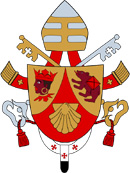|
LETTER
FROM THE HOLY FATHER
ON THE
OCCASION OF THE IV CENTENARY |
 |
 |
||
|
To
Our Venerable Brother On the occasion of the IV centenary of the death of St. Mary Magdalene de’ Pazzi, I am happy to join the beloved Florentine Church in her wish to remember her illustrious daughter, particularly dear to us all for her emblematic personification of a living love which represents the essential mystical dimension of every Christian life. As I affectionately greet you, dear Cardinal, and the entire diocesan Community, I give thanks to God for the gift of this Saint, who brings to every generation an intimate rediscovery through her ability to communicate such an ardent love for Christ and the Church. Born in Florence on 2 April 1566 and baptised at the font of “bel San Giovanni” (baptistery of St. John) with the name Caterina, St. Mary Magdalene de’ Pazzi revealed from a young age a particular sensitivity to the supernatural, and was drawn to intimate dialogue with God. As was customary for young girls of noble birth, her education was entrusted to the Dames of Malta, where she took her First Communion on 25 March 1576, and just a few days later eternally promised herself to the Lord with a vow of virginity. After returning to her family, she developed her study of prayer with the aid of the Jesuits who frequented the palace. With great ability, she was able to resist the conditioning of the mundane demands of an environment which, albeit Christian, was not enough to satisfy her desire to become more like her Spouse on the cross. It was in these circumstances that she reached the decision to leave worldly things behind her and join the Carmel of St. Mary of the Angels, in the village of san Frediano, where on 30 January 1583 she took the habit of the Carmel, and the name of Sister Mary Magdalene . After falling gravely ill in March 1584, she requested that she be allowed to make her profession early and on 27 May, the day of the Feast of the Trinity, she was carried into the choir on a cot and professed before the Lord her perpetual vows of chastity, poverty and obedience. From this moment on she had a period of intense mystical experiences, which were to give the Saint her reputation for great ecstasies. The Carmelites of St. Mary of the Angels recorded the extraordinary experiences of their young sister in five manuscripts. The “Forty Days” of the summer of 1584 were followed by “Dialogues”, from the first half of the following year. The culmination of the mystical knowledge which God gave sister Mary Magdalene of Himself is found in “Revelations and Knowledge”, eight days of sublime ecstasies that lasted from the eve of Pentacost to the Feast of the Trinity in 1585. An intense experience which, at only 19 years of age, enabled her to experience the entire mystery of salvation, from the incarnation of the Word in Mary’s womb to the descent of the Holy Spirit at Pentecost. This was followed by five long years of inner purification – which Mary Magdalene de’ Pazzi tells of in the book of “Probation” – during which her Spouse the Word took from her the feeling of grace and left her like Daniel in the lions’ den, surrounded by trials and great temptations. It is in this setting that her ardent commitment to the renewal of the Church arises, after beams of celestial light came down to show her the true state of the Church following the Council of Trent, in the summer of 1586. Like Catherine of Siena, she felt “compelled” to write a series of letters requesting the Pope, the Cardinals of the Church, her Archbishop and other pre-eminent ecclesiastical figures to undertake a “Renewal of the Church”, contained in the manuscript of that title. There are twelve letters in all, dictated in ecstasy, possibly never sent, but which remain as testimony to her passion for the Sponsa Verbi. Her gruelling trial came to an end at Pentecost 1590. This allowed her to dedicate her full energy to the service of the community, and in particular to the instruction of novices. Sister Mary Magdalene had the gift of living in communion with God in an increasingly interiorised way, becoming a model for her entire community, which to this day continues to regard her as a “mother”. The pure love which filled her heart opened her to the desire to become one with Christ, her Spouse, to the point of sharing with him the “naked suffering” of the cross. The last three years of her life were a true Calvary of suffering. Consumption began to manifest itself clearly: Sister Mary Magdalene saw herself forced to gradually withdraw from active community life, to immerse herself ever more deeply in the “naked suffering for the love of God”. She was oppressed by terrible pain, both physical and spiritual, which lasted until her death, on Friday 25 May 1607. She passed away around three o'clock in the afternoon, while an uncommon joy pervaded the convent. Fewer than twenty years after her death, she was beatified by the Florentine Pontiff Urban VIII, and her name was inscribed in the Canon of Saints by Pope Clement IX on 28 April 1669. Her incorrupt body is the object of constant pilgrimage. The convent in which the Saint lived is today the seat of the diocesan seminary of Florence, the city which worships her as Patron, and the cell in which she died became a chapel, in whose silence her presence can still be felt. St. Mary Magdalene de’ Pazzi remains to this day an inspiring presence for the Carmelites of Ancient Observance. In her they see the “sister” who walked the path of transforming union with God, and point to Mary as the “star” in the path towards perfection. For all, this great Saint has the gift of being a spiritual teacher, particularly for priests, for whom she always had a great passion. I sincerely hope the present celebrations in honour of her death make this luminous figure, who demonstrates to all the dignity and beauty of the Christian vocation, ever more widely known. Just as in life, when ringing the bells she entreated her sisters with the cry “Come, to love love!”, may this great mystic, from Florence, from her seminary, from the Carmelite convents and monasteries which take inspiration from her, continue today to be heard throughout all the Church, spreading the word of the love of God to every human being.
With this
wish, I entrust you, Venerable Brother, and the Florentine Church, to the
celestial protection of St. Mary Magdalene de’ Pazzi, and wholeheartedly
impart to all a special Apostolic Blessing.
The
Vatican, 29 April 2007 |
||||